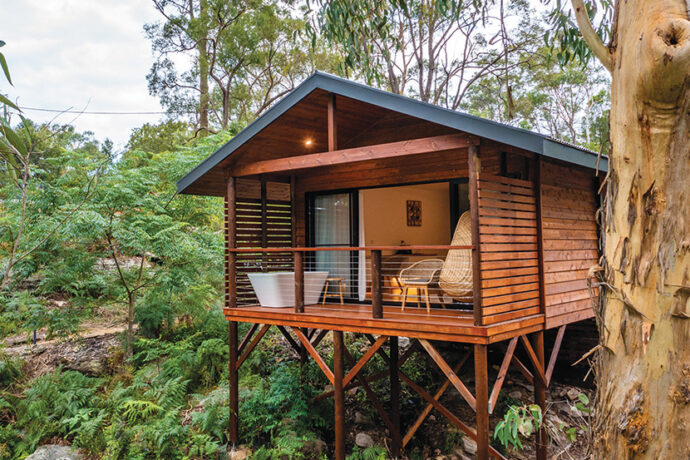
When we think of flying, we unfortunately also need to think about carbon emissions. Here we discuss what you can do to be a more sustainable traveller.
I recently travelled to Scotland for a conference, and while it certainly wasn’t my first time on a long-haul flight (Sydney to the United Kingdom via Dubai is no easy jaunt), I noticed more keenly than ever how much single-use plastic was in use. From plastic cups filled with a mouthful of water or juice, to serviettes and cutlery wrapped in plastic packets, I spent most of my time mid-air amazed – and appalled – at just how much waste is involved when flying. And that’s just the plastic!
As I’ve become more attuned to the effects of my lifestyle on the environment, the question of sustainable travel has become an important one. Travel, and particularly air travel, is more accessible than ever, from budget airlines offering cheap national or international flights to the evolution of technology that is cutting down just how long it takes to get anywhere. But just because we can, does that mean we should?
IS SUSTAINABLE AIR TRAVEL POSSIBLE?
The short answer to an unavoidable question for us island dwellers, is ‘not really’. For the average household, flying comes in at number six in the top 10 list of activities that cause the most carbon emissions. If you’re a frequent flyer, this can quickly become number one on that list. It is predicted that by 2050, 40 percent of the world’s carbon emissions will be generated by tourism. Currently, 72 percent of tourism’s CO2 emissions come from transport, with the remaining from accommodation, followed by tourist activities.
With this in mind, is it possible to indulge our wanderlust without being crippled by guilt about our carbon footprint? The good news is yes. It is. The World Tourism Organisation defines sustainable tourism as “tourism that takes full account of its current and future economic, social and environmental impacts, addressing the needs of visitors, the industry, the environment and host communities”.
When we talk about sustainable travel, then, it means finding a way to make tourism a long-term, manageable enterprise that doesn’t harm the natural and cultural environments we’re visiting. To do this, among other things, we need to be mindful of the various ways in which tourism can be negative so that we can work towards countering these to ensure our travels are beneficial to all involved – not just ourselves.
THE AIRBORNE ELEPHANT IN THE ROOM
Let’s start with the airborne elephant in the room: flying. As I mentioned before, the carbon emissions alone involved in flying are – ahem – out of this world. The first thing to do if you’re wondering about the carbon emissions involved in your trip is to do some research into the available airlines. While budget airlines are sometimes maligned as offering lower quality experiences, they are often more eco-friendly because they carry more passengers per flight and may have newer and more fuel-efficient aircraft. Obviously, this isn’t always possible, as some airlines only offer certain routes – but it’s an important point to consider.
Airlines themselves are becoming more and more eco-aware, and while you could shrug this off as corporations capitalising on the green revolution, we should support all positive steps towards a more sustainable industry. Carbon offsetting practices are one way airlines are trying to counter the carbon emissions generated by air travel. When booking a flight, you can choose to include an extra fee in your ticket price that the airline will then donate to a pre-selected carbon offset organisation. Each airline is different and will preselect the carbon offset organisation in question based on a variety of reasons, so again, it is important to do some research into the airline’s decisions.
The other option when considering carbon offsetting is to calculate the CO2 emissions involved in your flight and donate an appropriate amount to a carbon offset project of your choice. This way, you can research projects more thoroughly and choose your preferred way to offset – whether donating to a specific carbon offset organisation or perhaps a charity or community involved in planting trees, for example. Websites such as myclimate.org provide methods for calculating carbon emissions. When you have found the best airline for your flight, it is important to try and fly as direct a route as you can. Connecting flights mean greater distances travelled and more take-offs and landings, which cause most of a plane’s carbon emissions.
STAY AND PLAY SUSTAINABLY
Your class of travel can also have an impact. Business and first-class seats take up more space on the plane, and are more luxurious and thus heavier, than their somewhat squishier economy counterparts. Also, remember to pack as light as you can while remembering to include items like a reusable cutlery set, coffee cup and water bottle to help reduce your plastic use whether in the air or on the ground. Where possible, stay longer in the one place. Rather than squeezing in numerous stops, perhaps embrace being a slow traveller – it involves less flying and is more sustainable for the local communities you visit. Plus, you’ll get a richer experience of what that destination has to offer.
Where you choose to stay and what you choose to do and eat when you arrive at your destination is just as important in reducing your carbon footprint as how you get there. Opting for locally owned accommodation such as B&Bs and homestays ensures your hard-earned tourist dollars are supporting local people over faceless corporations. Airbnb is one such website that works to connect locals and homeowners in countries the world over with travellers wishing to visit more sustainably. You can further support local economies and communities by visiting family-owned restaurants and eateries as well as choosing local tour operators for all your sightseeing adventures. And when it comes to souvenirs, ask questions of retailers to ensure the origin and ethics of the trinkets you’re buying.
Ultimately, the key to ensuring that your globetrotting is as sustainable as possible comes down to the research you put into it. As individuals, we can often feel powerless in the face of the unsustainable practices that have a negative impact on our world, but the more pressure we put on corporations – starting with airlines and hotel conglomerates and ending with tour operators and retailers – the more we can influence how they do business. Remember, when we’re talking about sustainable tourism, we’re aiming to reduce our greenhouse gas emissions as much as possible. We also want to ensure our enjoyment of the world around us benefits not just ourselves, but the people, spaces and places we’re meeting and experiencing along the way.


























